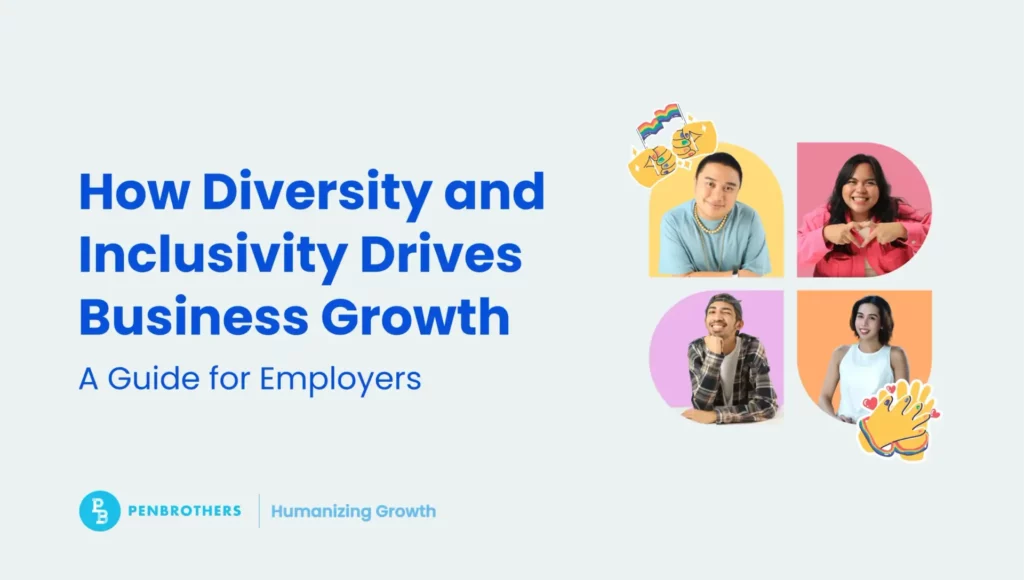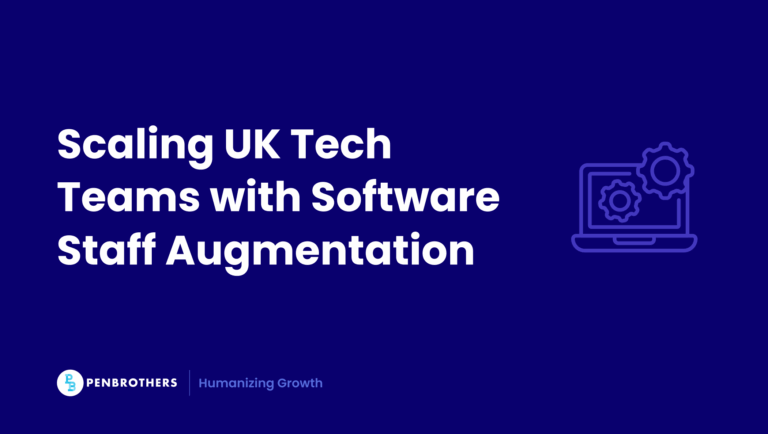Businesses of all sizes encounter differences in age, gender, race, and more among their workforce. These contrasting backgrounds may translate to challenges in collaboration and communication. When these areas of a team are not managed well, other aspects may also suffer. For example, productivity may slow down, or flexibility may decrease.
However, diversity and inclusion in the workplace are strong driving forces. These factors bring benefits to your company’s equity and ways of working. You can find 10 benefits of diversity and inclusion in the workplace below.
More than the benefits they bring, diversity and inclusion have an important place in your company. You can understand the deeper meaning behind them and learn from top companies around the world. You may then think of strategies for creating an inclusive workplace in your organization.
What Is Diversity and Inclusion in the Workplace?
Diversity and inclusion is a term that describes the representation and participation of different types of individuals in a company or organization. This term is used interchangeably with DEI or diversity, equity, and inclusion in the workplace. Although interconnected, each word in the term is distinct in meaning.
Diversity means all the ways that people are different from each other. These may be based on:
- Sex
- Gender
- Race
- Ethnicity
- Socioeconomic status
- Language
- Religion
- Age
- Physical abilities and disabilities
However, diversity also includes the various values, ideas, and perspectives people have based on their unique backgrounds. It also refers to skillsets, experience, and expertise that employees have accumulated in their education or past work.
Equity is the fair and equal treatment of all, especially employees. Everyone is given the same access, opportunities, and advancement as other groups of people as much as possible. Barriers are identified and removed for the underrepresented to receive the same benefits as others.
Finally, inclusion refers to the welcoming and hospitable culture of an inclusive workplace. It is a space where employees encourage one another to participate and contribute to work. At the same time, differences are celebrated and respected in words and actions.
10 Benefits of Fostering Diversity and Inclusion in the Workplace
1. Achieve Optimal Profitability Levels
Diverse, equitable, and inclusive work setups have proven to be more profitable. Based on a 2015 McKinsey report, the top companies in terms of DEI had 35% more chances to exceed median earnings. At the same time, more gender-diverse companies had a 15% likelihood to be more exceptionally profitable.
2. Boost Performance Rates
A diverse and inclusive team dynamics results in an array of business ideas. With well-represented perspectives, employees become more agile thinkers and learn more.
As a result, according to a study, teams with a diverse set of leaders end up performing 50% more. Another study from Deloitte Australia also discovered that performance increased 80% more in team-based assessments when workplaces are inclusive. With such high-performance rates, you may hit your goals faster and more efficiently.
3. Innovate and Sustain Success Metrics
Performance is not the only indicator driven by DEI-focused organizations. Innovation also increases when inclusivity fosters a myriad of ideas and perspectives among teams.
According to a study, an inclusive set of leaders resulted in 90% higher team innovation. Another study from Harvard Business Review saw 19% more innovation revenue from diverse companies. With this kind of boost in innovation, you can become a leader or a strong challenger in your industry.
4. Access a Wider Network of Candidates
By advocating DEI, your company may access more diverse talent. A wide talent pool is valuable in today’s labor landscape. The global talent shortage is leaving companies short on manpower and skills.
With your recruitment team valuing DEI, you can onboard talent that may bring much-needed skills and innovation to your company. Highly qualified talent drives better performance for your company.
5. Retain Talent with Highly Specialized Skills
When a team embraces unique talents, employees experience higher belongingness—the affirmation employees feel because of a progressive work culture.
As a result, employees who experience high levels of belongingness are 34% more likely to stay in their positions. Retaining valuable talent is an asset as well, or else you may have a hard time finding and hiring replacements.
Did you know? If you apply Maslow’s Hierarchy of Needs, as a principle, work usually provides the psychological and security levels. It’s considered the baseline. Companies powering through this era must appeal to the next level in Maslow’s pyramid: belongingness.
6. Collaborate with Top Talent
An inclusive workplace tends to be known through word of mouth, and job seekers like an inclusive company.
A study by Indeed found that 17% of job seekers consider diversity and inclusion as major factors in assessing if a company aligns with their goals. A report by the World Economic Forum also notes that 47% of millennial job seekers seek DEI from potential employers.
DEI makes positive impressions on top talent who wish to work with the best. This helps your business grow and address the talent shortage with the best workers out there.
7. Grow Your Business Faster with Less Risk
Part of business growth is reaching new markets and milestones. With a diverse and inclusive workforce, you gain multiple perspectives that help tap new customer demographics. You gain 70% more chances of capturing new markets.
If you can, hire talents from the region or location you aim to penetrate. With this, you can grow your business and expand while minimizing business risks.
Did you know? Angel investors and venture capitalists are taking DEI seriously. They believe that a diverse team running a startup is worth their time, budget, and effort. Companies that advocate fairness and deliver results consistently are closer to a better valuation, too.
8. Make More Impactful Business Decisions
Because of diverse employees’ various backgrounds, work experiences, and expertise, a larger perspective is created when handling matters. When decisions need to be made, a more holistic perspective is considered and more educated decisions are made.
Based on a PwC study, diverse teams have 87% smarter decision-making abilities than non-diverse teams. Because of these smarter choices, you may see better profitability, less business risk, more innovation, and higher market success.
9. Provide Demand-based Business Solutions
With a high DEI in a company, you can offer products or services relevant to your market. Customers will only understand and appreciate your products or services if your workforce has the same understanding and appreciation. Product or service ideas, the language you use in your marketing, your branding, and everything you put forward to your market should connect with them. Connection can only be done through diversity and inclusivity in the workplace.
10. Future-proof Your Business
Diversity makes for resilient companies. A company can flourish through crises because of the diverse ideas and perspectives in an inclusive workplace.
For example, the 2007-2009 financial crisis saw a 35% stock decline in most companies. However, inclusive organizations grew in value by 14%.
You can power through an economic downturn with a well-structured team. It’s not easy but can be done with the right mindset and the right people to back you up.
Why Be Diverse and Inclusive in the Workplace
With all the benefits of diversity and inclusion in the workspace, your company will gain an edge over your competitors.
You will have a stronger drive to deliver results consistently. You will have a solid foundation of ideas and perspectives that help your company stay flexible and adaptable to changing times. At the same time, you gain an innovative advantage that may place your organization on the industry map as a market leader or a formidable challenger.
The benefits of diversity and inclusion speak for themselves. You can gain all of these boosts by creating an inclusive workplace. You may take inspiration from the following examples and learn from their strategies for fostering diversity and inclusion in the workplace.
10 Workplace Diversity Examples from Around the World
Accenture
As one of the leading consultancies in the world, Accenture provides diversity training for awareness, management, and professional development. It is a constant leader in the Disability Equality Index, the Bloomberg Gender-Equality Index, and the World’s Most Ethical Companies.
Julie Sweet, CEO of Accenture, shared the company’s belief that “people with diverse perspectives and lived experiences are the drivers of innovation.”
Best Practice You Can Apply:
Conduct diversity training regularly. It helps educate long-time workers to be inclusive regardless of their own backgrounds.
Johnson & Johnson
With more than 140,000 workforce, Johnson & Johnson aims to place women in 50% of management positions around the world by 2025. It also aims to foster 35% racial diversity in its management positions in the US. As part of its diversity programs, the corporation has Employee Resource Groups that help create inclusion.
Joaquin Duato, CEO of Johnson & Johnson, was proud to say that their ERGs improved how the company worked and because of that, ERGs have become a core part of how Johnson & Johnson innovates.
Best Practice You Can Apply:
Provide diverse employee support. It promotes belongingness and inclusivity, boosting employee morale. Also, consider opening roles to more women if there’s a gender gap in your current organizational structure.
Marriott
The hospitality giant, Marriott, employs women-owned businesses as 10% of its supply chain. Half of its global workforce and half of its US leadership are also diverse.
The corporation’s dedication to women in leadership is shared by its CEO, Anthony Capuano. He shared that developing business outcomes that boost economic growth can be achieved by elevating women in the industry and hotel ownership.
Best Practice You Can Apply:
Appoint women of all ages and backgrounds to lead a few major projects and see how they pan out. To ensure diversity, members of the said projects must be from diverse perspectives, too. Fresh perspectives open more opportunities for growth, development, and expansion.
West Midlands Fire Service
In terms of diversity and inclusion in the workplace in the UK, West Midlands Fire Service sits at the top. Their late Chief Fire Officer ensured that barriers were lifted to allow participation and equality for all. Today, 17% of the fire force is female and 21% represent the Black, Asian, and ethnic minority groups.
Best Practice You Can Apply:
Welcome racial representation and find time to immerse in their cultural nuances, too. Different racial backgrounds bring new perspectives for innovation and better services.
UK Power Networks
The UK’s biggest electricity distributor is headed by Basil Scarsella who is committed to implementing the values of the company: ”Diversity and Inclusiveness” and “Respect”.
Its senior leadership team aimed to achieve and did reach the National Equality Standard, which is the benchmark for an inclusive workplace. One of its initiatives is the formal collection of staff equality and diversity data. Inclusivity is then regularly discussed by the Board of Directors.
UK Power Networks also have their leaders join Inclusive Leadership Workshops. Recruitment teams and managers were trained to recognize and reduce unconscious bias during hiring. The company also has initiatives regarding underrepresented black men, neurodiverse teenagers, and Armed Forces service leavers.
Best Practice You Can Apply:
Collect diversity data and provide actionable items that will fine-tune ways of working vis-à-vis desired business outcomes. Information and data help inform unbiased decision-making in the recruitment process.
Hastings Direct
Hastings Direct is another one of the top diversity companies in the UK. Its recruitment team prioritizes candidates from different backgrounds based on demographic diversity monitoring in the office, which is also the basis of the company’s #CountMeIn campaign.
As a result, 83% of their employees report being able to be themselves. Hastings Direct actively supports a range of religions with multi-faith prayer rooms and faith-based dietary options, such as halal, vegan, and vegetarian.
At the same time, the gender split in the company is straight down the center with half male and half female. This is reflected in leadership too with half of the company board being women.
Best Practice You Can Apply:
Support multiple faiths but do so by setting a defined scope and limit. Allow your team members to take part in their religious traditions. Reflect these events in the work calendar so that everyone is aware and can adjust timelines accordingly.
Speaking In Colour
Speaking In Colour is an Aboriginal-owned education organization that espouses diversity in the workplace in Australia. The company promotes Aboriginal and Torres Strait Islander awareness and representation. At the same time, the Speaking In Colour team is all Aboriginal Women.
Best Practice You Can Apply:
Get the thoughts and honest feedback of minority groups in your workspace. Minority ethnic individuals have even more unique perspectives that may result in innovative solutions, products, or services in the company.
TDC Global
TDC Global is a DEI consultancy firm that practices DEI. The company values intersectionality and recognition of the differences of every individual worker. It also looks at the impact of gender, generational, and cultural diversity to create programs and strategies to address workforce diversity.
Best Practice You Can Apply:
Integrate diversity and inclusion into your company values. Organizational treatment of diversity and inclusion makes the transition smoother and faster.
Australian Bureau of Statistics
Despite being an independent statistical agency of the Australian government, the agency encourages applications from:
- Ethnic minorities
- People with disabilities
- Mature age workers
- LGBTQI+ people
The agency provides diverse worker support through its different employee networks. Simultaneously, the agency laid out its diversity plan early on in an ABS Inclusion and Diversity Study 2018-21 for a more inclusive workplace and diverse workforce.
Best Practice You Can Apply:
Plan and ensure that the said plan is executed, assessed, and refined. Include a well-represented team in all phases of the planning session. Diversity and inclusion do not happen overnight. Design short-term and long-term plans to scale your workforce accordingly.
The Social Space
Leading the pack for diversity and inclusion in Singapore, this business promotes skill acquisition for persons with disabilities. It also gives more than 50 beneficiaries with vocational training and employment. Its beneficiaries include single mothers, ex-offenders, special needs individuals, and other demographics.
Best Practice You Can Apply:
Build up skills among willing and able team members. Diverse employees will need diverse skills. Invest in their education and consistent training to make the most out of diversity and inclusion.
Filipino Workers Contribute to DEI
Diversity is a part of the Filipino workers’ DNA. This workforce brings unique backgrounds, skills, expertise, and perspectives to the companies they work for.
Nicolas Bivero, CEO and Co-Founder of Penbrothers who advocates diversity and remote teams in the Philippines shares, “Filipinos are some of the warmest and friendliest people I have ever worked with, they value a sense of camaraderie as much as they maintain respect.”
Devy Romulo is a good example. She is a tech Business Analyst for Servantex. The company provides hospitality workforce management solutions, and Devy manages non-system administrative responsibilities. However, as a transgender woman, Devy also contributes to the diversity and inclusion of Servantex.
Devy is also an offshore Filipino employee. Her unique setup gives her a fresh perspective that Servantex has been able to leverage at a fraction of the salary that an in-office tech business analyst would have cost. Because of offshoring staff to the Philippines, Servantex incurred minimal labor costs while retaining top talent.
Integrate DEI Efforts Consistently with a Reliable Partner
DEI is fast becoming a driving factor in employee management in companies around the world. Your company will do well to invest in diversity and inclusion in the workplace as well. Diversity and inclusivity foster kapwa-tao, a Filipino cultural value that promotes respect, dignity, fairness, and good communication between people of all demographics.
Kapwa-tao is a core principle embedded in Filipino culture itself. You can access all the benefits of diversity and inclusivity mentioned above by hiring remote workers from the Philippines. Filipino remote workers will bring fresh perspectives, skills, and knowledge to boost your company in many ways.






